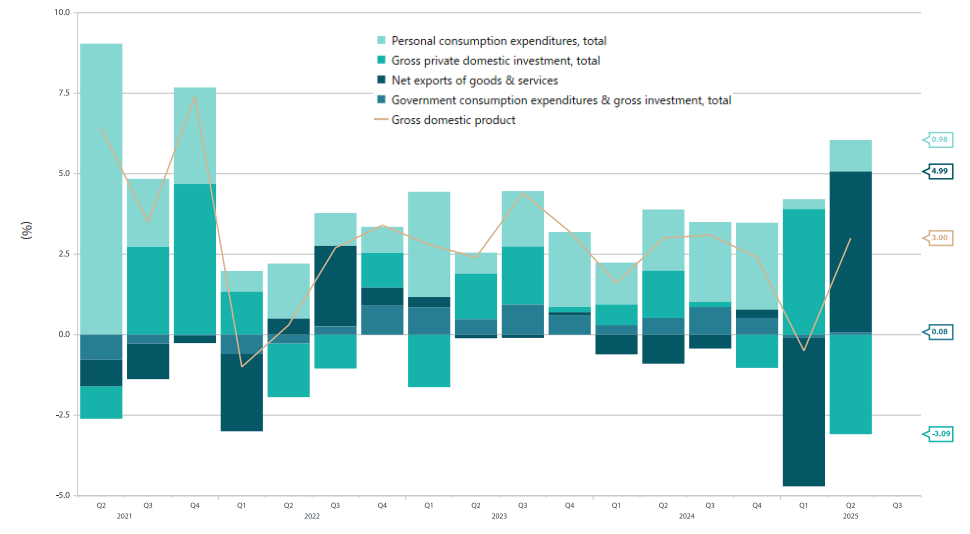NEWS

25 Aug 2025 - Manager Insights | Argonaut Funds Management
|
Chris Gosselin, CEO of FundMonitors.com, speaks with David Franklyn, Managing Director and Co-Head of Funds Management at Argonaut. David outlines the Argonaut Natural Resources Fund, launched in 2020, which has delivered strong returns by investing across mining companies from majors like BHP to small-cap explorers. He highlights the fund's focus on themes such as energy transition and geopolitical risk, with gold as a safe haven and copper as the key growth driver, while noting that resources remain undervalued but vital to global growth.
|

The following article features insights in response to reader questions on investment strategy, asset allocation, and risk management.
22 Aug 2025 - Shares, Property, Volatility & More
|
Shares, Property, Volatility & More Marcus Today August 2025 |
|
The following article and video features insights from Marcus Today in response to reader questions on investment strategy, asset allocation, and risk management. While the views expressed are those of the author and reflect his personal investment philosophy, the principles discussed--such as comparing asset classes, managing volatility, and understanding leveraged products--are broadly relevant to investors and financial professionals. Readers should consider these perspectives alongside their own objectives and risk tolerance. Should You Sell a Paid-Off Investment Property?Ben asked: If the investment property has been paid off, should you sell it and invest in the stock market for a better return? There are a couple of things in there, Ben, which need to be debated. One is, does the stock market give you a better return? The answer to that is -- if the person who's investing is any good, because it is a skill -- then the returns would be better than the investment property, where the asset class grows rather slowly. So I would say the stock market in the right hands is better than the investment property. Should you sell an investment property just because it has been paid off? All I would say to you, Ben, is it's entirely personal. What are you trying to achieve with your investment property? If you're good at investing in property, it's succeeded for you, you know what you're doing. Maybe gear up and buy another investment property, if that's what you're good at. People should stick to what they're good at. So there's no one answer to this question. If the investment property has been paid off, it's entirely down to you -- what you want to do next. Should you put it in the stock market? Only if you know what you're doing.
Dividends vs Rent - Does Frequency Matter?Vishal asked: One of the problems with Australian shares is that they only pay dividends twice a year. Property puts rent in your pocket every week. What are your thoughts on that? Again, entirely a personal choice. Do you need income every month? Or does it not disturb you to get it every six months? I would say to you that wealthy retirees really don't care about needing cash. If you need a regular cash flow, you haven't got enough money, and you're a little bit desperate. Because most wealthy people will have enough money around to see them over for six months in between dividends from shares. Yes, you can spread it out with property, but also what you can do is spread it out with shares. For instance, the CBA pays a dividend, and then three months later ANZ, NAB and Westpac pay a dividend. And then three months later, CBA pays a dividend. So you see, you can put together a portfolio that pays at different times. There used to be a good table -- which you could do yourselves -- which shows you when, because they go ex-dividend the same time and they pay the same time every year, or almost every share. You could grab the top 20 income stocks. You could have a look at our Income Portfolio for some of those, grab the top 20 income stocks and see what month they pay. And you could buy them in proportions that would give you an income over time. But as I say, most wealthy retirees don't really care about the infrequency of getting a dividend. What they're really after is the big lump of franking credit refunds they get at the end of the year -- which you get once a year -- when they put their tax return in. And that's really what they're interested in. And they just budget the whole thing over the year. So no, I don't think there's any problem with shares paying twice a year instead of every month compared to property.
Volatility Is Normal - But ManageableRick asked: How do you look past volatility in the share markets, when the USA is so central to confidence in its performance? You don't. The share market is clearly mentally more volatile than property, and that's one of the great benefits of property -- it doesn't get reported to you in the media every night. Every morning, "the market did this, the market did that." "Your house has gone down 0.3% today, it's up 2%." That would freak you out as much as shares freak you out at the moment -- if it was being reported on all the time. So the impression is the property market is less volatile. How do you manage volatility in shares? Well, you manage it. Most of the market doesn't understand. Most people sitting at a dinner party talking shares will talk about BHP and the CBA in the same breath -- when the BHP share price is moving 5% a week and the Telstra share price moves 2% a week. It's two and a half times more risky, more volatile. Every share, every return you get, has a level of risk. You can work that out using average true range percentage of the share price -- we talk about that in the newsletter a lot -- but you need to understand volatility and risk has to be managed to match you. You have to match it to your own personal investing style. So that's how you handle the volatility -- by being aware of it and managing it. You can't get away from it. The fact that the property market appears less volatile and allows investors to sleep at night -- that's fine. You sleep at night. But I reckon I'll make more money in the stock market if I know what I'm doing. With the volatility, I just have to make sure I manage the volatility. And as you'll know, in any market today, remember -- we all know -- the way we manage the precipitous moments is we cash out. It is less risky. The whole market will tell you you can't time the market. "It's time in the market, not timing the market." I think that's wrong. And I believe timing the market is less risky than giving it to a fund manager who sits in the market come what may with some idea that it's all about the long term. What we do -- cashing out occasionally, getting back in again -- is going to get you a better return and is less risky than somebody who tells you all those Buffett-esque quotes about it being in the long term. "Don't buy anything for ten minutes you wouldn't hold for ten years." Absolute rubbish. You have to time the market, and it's less risky to do that. Geared ETFs - Use With Caution Scott asked: What are your thoughts on leveraging in shares via geared ETFs like GGUS, GEAR etc., if the investor understands the risk? Careful. If you treat some of these synthetic ETFs as investments, you will find they don't do what the underlying index does. Geared ETFs -- if they're created using derivatives -- are going to short-term do what the market does. Longer-term, they won't. Because if they've got derivatives involved, they constantly lose time value. So if you were to, say, buy a synthetic derivative-leveraged ETF over the Nasdaq -- to create that, you're constantly losing time value. So it will underperform the Nasdaq over the longer term. In my view, geared ETFs are for trading. They are not for long-term investment. So if you thought you were going to buy GGUS instead of the US market because you thought the market was going to go up long term, you're going to be disappointed. Because it's going to underperform long-term, because it's being created out of derivatives. Derivatives lose value all the time as time goes past. Slightly complicated -- but look up time value of options, or time decay in derivatives. DISCLAIMER: This content is for general information purposes only and does not constitute personal financial advice. Please consider your own circumstances or seek professional advice before making investment decisions. |
|
Funds operated by this manager: |

21 Aug 2025 - Growth amid structural changes

500 and NASDAQ increased +2.2% and +3.7%, respectively,
whilst in the UK, the FTSE rose +4.2%.
20 Aug 2025 - Glenmore Asset Management - Market Commentary
|
Market Commentary - July Glenmore Asset Management July 2025 Global equity markets had a solid month. In the US, the S&P 500 and NASDAQ increased +2.2% and +3.7%, respectively, whilst in the UK, the FTSE rose +4.2%. Domestically, the AllOrdinaries Accumulation index was broadly in-line with its US peers, rising +2.6%. This was led by the Healthcare (+8.7%) and Resources sectors (+4.5%), which benefitted from a rotation out of Banks (-1.3%), following a period of strong outperformance. Investor sentiment during the month was buoyed by the announcement of several US related trade deals, including with the European Union, Japan and South Korea, amongst others. As it stands, the "effective tariff rate" from the US is set to rise from an average of ~2% in 2024 to ~16%. Whilst the impact of this remains unclear, investors will undoubtedly be keeping an eye on economic data over the coming months. Closer to home, June quarter 2025 domestic inflation figures came in slightly weaker than expected, with the trimmed mean CPI (the RBA's preferred measure of underlying inflation) declining to 2.7% (YoY) from 2.9% in 1Q-2025. As a result, financial markets now expect to the RBA to cut the cash rate by 25bps during the upcoming 12th August meeting. In bond markets, the US 10-year bond yield rose +15 basis points (bp) to 4.37%, whilst its Australian counterpart rose +10bp to close at 4.26%. The Australian dollar was weaker in June, closing at US$0.643, down 1.6 cents. Funds operated by this manager: |

19 Aug 2025 - Investment Perspectives: 10 charts shaping our thinking

18 Aug 2025 - Manager Insights | Digital Asset Funds Management
|
Chris Gosselin, CEO of FundMonitors.com, speaks with Clint Maddock, Director and Co-Founder at Digital Asset Funds Management, about the firm's Digital Income Fund and its market-neutral arbitrage strategy in the cryptocurrency space. Clint explains how the fund has delivered consistent double-digit annual returns with minimal drawdowns, and why growing mainstream adoption of digital assets continues to create opportunities.
|

15 Aug 2025 - Fed, BOJ and China navigate uncertain growth and inflation paths
|
Fed, BOJ and China navigate uncertain growth and inflation paths Nikko Asset Management August 2025 Firm US GDP supports Fed's decision to keep rates on hold for nowThe Federal Reserve (Fed) kept rates on hold on 30 July, maintaining the policy rate in a range between 4.25% and 4.5%, following stronger-than-expected US Q2 GDP data. Although the Fed's rate decision was widely anticipated, the first double dissent in 30 years--from Fed governors Christopher Waller and Michelle Bowman--highlighted a divergence in outlooks among Federal Open Market Committee voters. Waller and Bowman pointed to early signals of softness in the labour market, although data suggest that economic activity continues to be supported by offsetting factors, even in the post-2 April world. In Q2, US consumption made a positive contribution to growth, albeit less strongly than in late 2024 (Chart 1). However, a significant expansion in net exports--compensating for front-loaded imports in Q1--more than offset a decline in private domestic investment and subdued government consumption. Still, US growth remains influenced by temporary factors, and households may not yet have felt the full brunt of US tariffs. Fed Chair Jerome Powell acknowledged emerging risks in the labour market but emphasised that employment is closer to one of the Fed's goals of full employment than inflation is to its mandate of price stability. Supporting Powell's point, the US core PCE index posted a smaller-than-expected decline, falling from 3.5% in Q1 to 2.5% in Q2, meaning that it is still half a percentage point above the Fed's target. Chart 1: US GDP contributions (seasonally adjusted, annualised rate)
Source: Nikko Asset Management, Hutchins Center on Fiscal & Monetary Policy, BEA Tariff deadline rush underscores reasons to wait and seeA deluge of new information on US tariffs continues to pour in, with the market and the US economy still trying to digest its implications. Tariff rates range widely, from 15% on exports from heavyweight South Korea to a higher-than-expected 25% on Indian goods. The only constant appears to be that tariffs remain subject to upward pressure, although the situation is perhaps not as severe as some worst-case scenarios had projected. The full economic impact of the newly agreed tariffs remains unclear, but it is likely that the most significant effects of the US tariff war still lie ahead. As we pointed out in Global Investment Committee's outlook: narrowing growth differentials , a New York Fed corporate survey shows that most companies plan to pass on tariff costs, at least partially, and that they typically do so with a lag of one to three months. Since we are not even a month past the initial 4 July "reciprocal" tariff deadline announced in April, further pass-through may still be pending in inflation data. Of course, the timing of such price rises may not be ideal as the job market has shown early signs of softening. However, repeated micro-adjustments to global supply chains and prices that result in consistent shocks may work against arguments for rate cuts based on labour market weakness. This could be particularly true if consumers internalise such repeated shocks and adjust their long-term inflation expectations upward. It is worth noting that once internalised and passed through into long-term expectations, inflation tends to be sticky. As such, it is not certain if the prevailing effect will ultimately be a decline in demand driven by rising unemployment. BOJ stands pat but slightly more hawkish on growth and inflation outlookThe Bank of Japan (BOJ), like the Fed, opted on 31 July to remain in wait-and-see mode, keeping its policy rate on hold at 0.5%. However, in its updated outlook the BOJ modestly revised its near-term growth view from 0.5% to 0.6%. In addition, it significantly revised its near-term core CPI outlook from 2.2% to 2.7%. The central bank also modestly upgraded its longer-term core CPI projection; its two-year forward CPI forecast was revised back to 2% from 1.9%. These revisions, all else equal, provide a greater argument for a more hawkish BOJ compared to May. Meanwhile, the assumption that core CPI will slow from 2.7% in the current fiscal year to 1.8% in the next is highly dependent on the pricing-out of fresh food prices and absence of other inflationary factors going into fiscal 2026. Should prices remain more robust over late 2025 and household purchasing power stay intact, the BOJ may be prompted to bring forward its rate hike timeline. Our central scenario remains that the BOJ is likely to hike rates before the end of 2025. China's Politburo also in wait-and-see mode, keeps policy powder dryAmid the global wave of data, China's Politburo expressed confidence in the resilience of the Chinese economy but has so far refrained from offering new policy measures. As trade negotiations with the US have now been extended, China could be trying to maintain some dry powder to react to the eventual outcome of the talks--particularly if it poses any additional challenges to external demand. A key development is the 4th Plenum in October, which will focus on the 15th Five-year plan (2026 to 2030). This event may provide an opportunity for new policy announcements in response to what is revealed after extended China-US trade talks. By October, the need for consumption-focused stimulus may become apparent, particularly if China's current "anti-involution" campaign--aimed at curbing excessive capacity--proves ineffective in offsetting price declines stemming from households' soft demand and precautionary savings. Funds operated by this manager: Nikko AM Global Share Fund , Nikko AM ARK Global Disruptive Innovation Fund , Nikko AM NZ Cash Fund , Nikko AM NZ Corporate Bond Fund , Nikko AM Core Equity Fund (NZ) , Nikko AM Global Shares Hedged Fund (NZ) , Nikko AM KiwiSaver Scheme Balanced Fund (NZ) , Nikko AM ARK Disruptive Innovation Fund (NZ) Important disclaimer information Please note that much of the content which appears on this page is intended for the use of professional investors only. |

14 Aug 2025 - Expert Analysis of the RBA's August 12 Rate Decision
|
Expert Analysis of the RBA's August 12 Rate Decision FundMonitors.com August 2025 |
|
Chris Gosselin, CEO of FundMonitors.com, speaks with Nicholas Chaplin, Director and Portfolio Manager at Seed Funds Management, and Renny Ellis, Director & Head of Portfolio Management at Arculus Funds Management, following the Reserve Bank of Australia's surprise 25 basis point rate cut. The panel debates whether the decision was justified or politically driven, explores its implications for inflation, the property market, and investors, and examines the potential for further rate cuts. They also discuss global influences, including U.S. tariffs and their impact on inflation and markets. |

14 Aug 2025 - Sustainable equities outlook: AI's transformative role in an evolving global economy
|
Sustainable equities outlook: AI's transformative role in an evolving global economy Janus Henderson Investors August 2025 Portfolio Manager Hamish Chamberlayne explores how, in a world marked by geopolitical upheaval, artificial intelligence (AI) is transforming traditional economic forces, presenting both opportunities and challenges. In today's world, characterised by heightened confusion and unpredictability, geopolitical dynamics are increasingly overshadowing traditional economic forces. Nations worldwide grapple with declining workforce participation, ageing demographics, unproductive government expenditure, and substantial fiscal deficits. Yet, within this turbulent landscape the secular drivers of sustainable investing remain intact. Secular investment trends around electrification, renewable energy, digitalisation, AI, and reshoring are progressing uninterrupted Last year, investment in the green transition reached unprecedented levels, surpassing US$2 trillion for the first time.1 The majority of this funding was directed towards established technologies such as renewable energy, energy storage solutions, smart grids and electric vehicles (EVs). Despite the recent stagnation of US climate initiatives, Europe and China are intensifying their clean energy and broader sustainability efforts. Global EV sales this year are forecast to grow by 25% (22 million) compared to 2024, with China accounting for almost two thirds, followed by Europe (17%).2 Even in the US, EV sales are set to grow by 7% this year despite the Trump administration's withdrawal of federal support. Meanwhile, President Trump's 'Big Beautiful Bill' will provide significant government funding, grants and tax incentives for companies investing in the US. Reshoring manufacturing and developing supply chain resilience in critical minerals are set to underpin a prolonged investment cycle, which is further fuelled by the gigantic levels of investment going towards AI infrastructure. The large tech companies dubbed the 'Magnificent 7' are spending in excess of half a trillion dollars3 annually in the race for AI supremacy. All of this investment is resource and labour intensive and we see sustained growth in demand for power and electrification infrastructure to support it. The role of AI in decarbonisation These high levels of investment provoke questions about environmental sustainability. The build out of all this AI and electrification infrastructure is also carbon intensive and we are paying close attention to the fact that carbon emissions are not going in the right direction. Although we are concerned by this uptick in emissions, we are optimistic that AI will ultimately play a beneficial role in decarbonisation efforts through advancements in innovation and productivity; and we remain confident that the growing demand for energy will be met with increased investments in clean energy solutions. At Janus Henderson we have a proprietary climate transition analysis tool, and we are maintaining close engagement dialogue with our investee companies regarding their decarbonisation pathways. Thus far, we are pleased to report that we have seen no evidence from the companies we invest in that their corporate sustainability initiatives are slowing. In fact, we see that companies worldwide keep setting net-zero targets and pouring capital into efficiency, waste reduction and supply-chain resiliency, providing durable foundations for our sustainable investment themes. Running hot - a fiery economy ahead? Coincident with these high levels of investment, government deficits are expected to remain large, and this is supportive of corporate profitability and asset prices. When combined with easing monetary policy, and pro-growth changes to banking regulation, we believe this is a positive backdrop for global equity markets. Sustainable fundamentalsOur team continues to concentrate on companies positioned to benefit from these enduring sustainability trends. For example, we favour sectors such as industrials and information technology - areas replete with innovators solving efficiency and climate challenges. Companies within electrical equipment, professional services, software, renewables, automotive technology and infrastructure are exposed to the secular themes of electrification, digital services, AI and decarbonisation. These companies are capitalising on booming demand and are exactly the kind of "picks-and-shovels" providers enabling this digital, electric and green future that the world is transitioning towards. We believe it is important to seek out high-quality businesses with strong free cash flow and durable growth. This discipline tempers volatility during market shocks. It echoes lessons from 2020, when companies with robust financials and sustainable moats (competitive advantage that helps protect a company's profitability) proved far more resilient. By "staying on the right side of disruption" - i.e. investing in firms driving change rather than those at risk from it - we believe investors can better weather turbulence and capture superior growth over time. This means being incessantly forward-looking in approach. Our thesis is grounded in the principles of durability allied with innovation - as Peter Drucker, the Austrian American author and consultant who helped develop modern management theory, reminds us:
|
|
Funds operated by this manager: Janus Henderson Australian Fixed Interest Fund , Janus Henderson Conservative Fixed Interest Fund , Janus Henderson Diversified Credit Fund , Janus Henderson Global Natural Resources Fund , Janus Henderson Tactical Income Fund , Janus Henderson Australian Fixed Interest Fund - Institutional , Janus Henderson Conservative Fixed Interest Fund - Institutional , Janus Henderson Cash Fund - Institutional , Janus Henderson Global Multi-Strategy Fund , Janus Henderson Global Sustainable Equity Fund , Janus Henderson Sustainable Credit Fund 1Source: International Energy Agency, 'World Energy Investment 2025'. 2Source: BloombergNEF, 'Long-Term Electric Vehicle Outlook 2025', 18 June 2025. 3Source: Financial Times, 'What'll happen if we spend nearly $3tn on data centres no one needs?', 30 July 2025 Deficit: A government deficit occurs when expenses exceed revenues (or taxation). Equity: A security representing ownership, typically listed on a stock exchange. 'Equities' as an asset class means investments in shares, as opposed to, for instance, bonds. To have 'equity' in a company means to hold shares in that company and therefore have part ownership. Free cash flow: the amount of cash a company has left after paying operating expenses and capital expenditure. Fiscal/Fiscal policy: Describes government policy relating to setting tax rates and spending levels. Fiscal policy is separate from monetary policy, which relates to control of interest rates and the money supply and is typically set by a central bank. Magnificent 7: A group of seven dominant tech companies - Alphabet, Amazon, Apple, Meta, Microsoft, Nvidia and Tesla - that have helped drive strong returns in the US stock market in recent years. Net zero: A target of achieving a balance between greenhouse gases emitted into the atmosphere and the amount removed from it. Greenhouse gases are those that contribute to climate change. Secular: In economics, this refers to trends that are long term and sustained, distinct from short-term seasonal variations or the business cycle (expansion and Volatility: The rate and extent to which the price of a portfolio, security or index moves up or down. References made to individual securities do not constitute a recommendation to buy, sell or hold any security, investment strategy or market sector, and should not be assumed to be profitable. All opinions and estimates in this information are subject to change without notice and are the views of the author at the time of publication. Janus Henderson is not under any obligation to update this information to the extent that it is or becomes out of date or incorrect. The information herein shall not in any way constitute advice or an invitation to invest. It is solely for information purposes and subject to change without notice. This information does not purport to be a comprehensive statement or description of any markets or securities referred to within. Any references to individual securities do not constitute a securities recommendation. Past performance is not indicative of future performance. The value of an investment and the income from it can fall as well as rise and you may not get back the amount originally invested. Whilst Janus Henderson believe that the information is correct at the date of publication, no warranty or representation is given to this effect and no responsibility can be accepted by Janus Henderson to any end users for any action taken on the basis of this information. |

13 Aug 2025 - 10k Words |August 2025
|
10k Words Equitable Investors Aug 2025 Apparently, Confucius did not say "One Picture is Worth Ten Thousand Words" after all. It was an advertisement in a 1920s trade journal for the use of images in ads on the sides of streetcars... There's a healthy spread between the volatility investors are pricing in for small caps relative to large caps but high yield ("junk") spreads are near historical lows. Sticking with the small-big spread, the price/book chart is smiling back at you. Valuations for high growth companies have shot away from the pack, giving the US market an edge over Australian multiples - but with both above fair value according to Morningstar. ASX large caps have seen more upgrades than downgrades in the week leading into reporting season. We divert to look at the split of assets between generations and the affordability of housing; stablecoins becoming relevant players in the US treasuries market; China's declining population of workers; and finally volatility for "Dr Copper". Spread between VIX (S&P 500 implied volatility) and Russell 2000 VIX (small cap implied volatility) 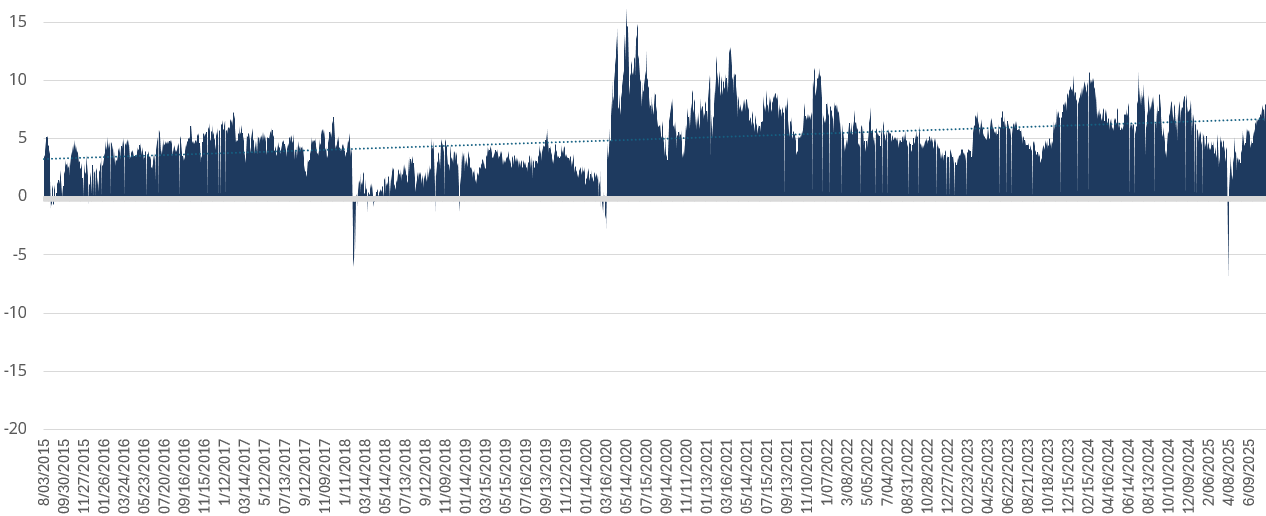
Source: Equitable Investors ICE BofA US High Yield Index Option-Adjusted Spread 
Source: FRED (Federal Reserve of St Louis) Premium in US large caps' price/boom multiples is the widest in 25 years 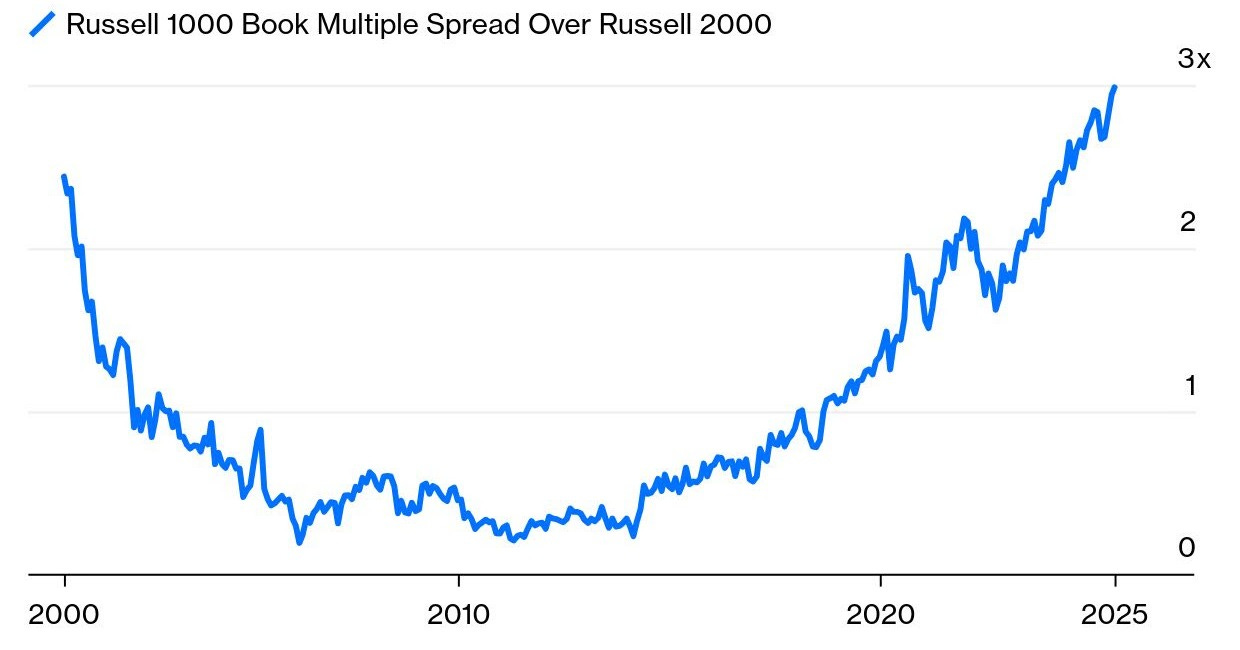
Source: Bloomberg Recent multiple expansion in "high growth" (>25% YoY growth) companies 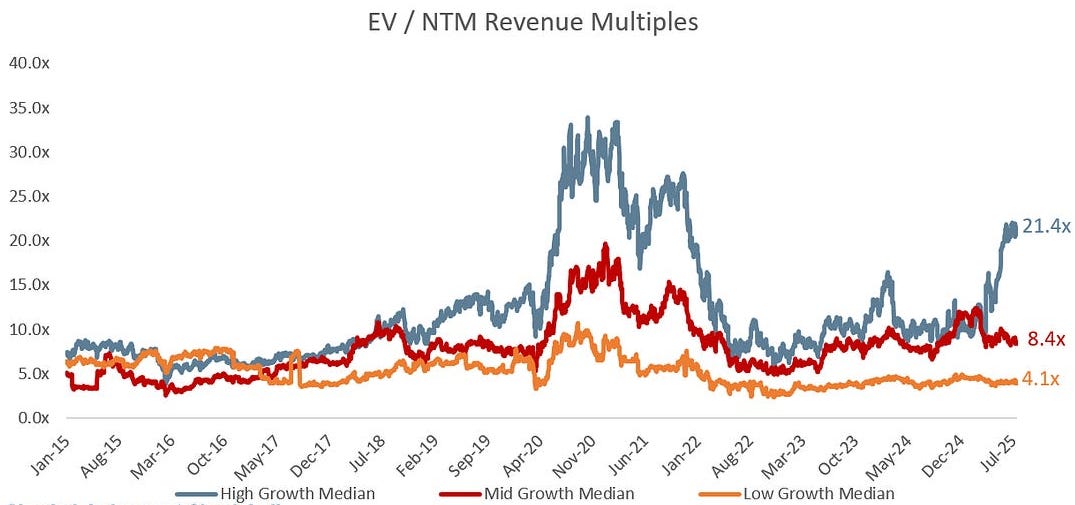
Source: Altimeter via Clinton Capital Forward P/E - US v Australia 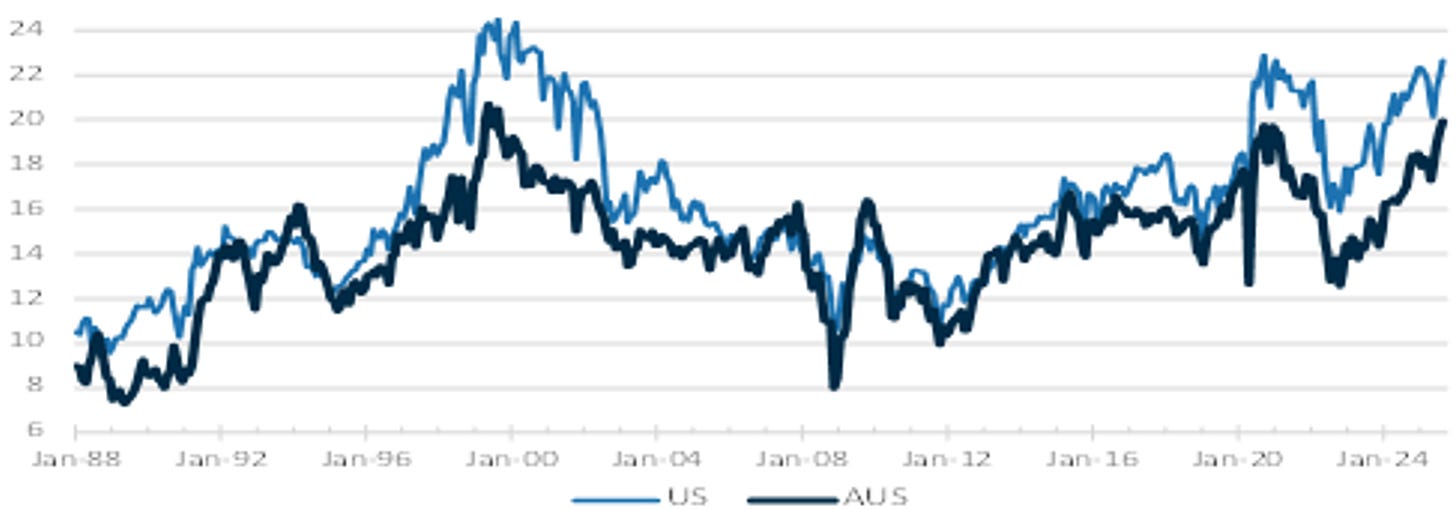
Source: Ord Minnett Australian market trading above Morningstar's bottom-up fair value estimate 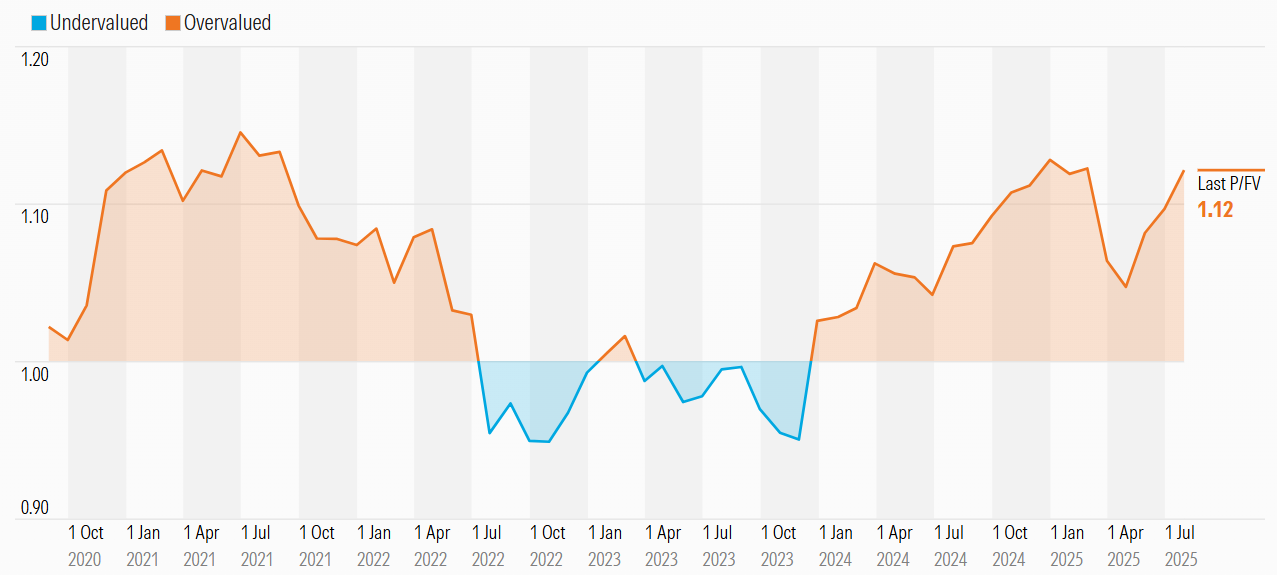
Source: Morningstar US market has also return to a premium v bottom-up fair value 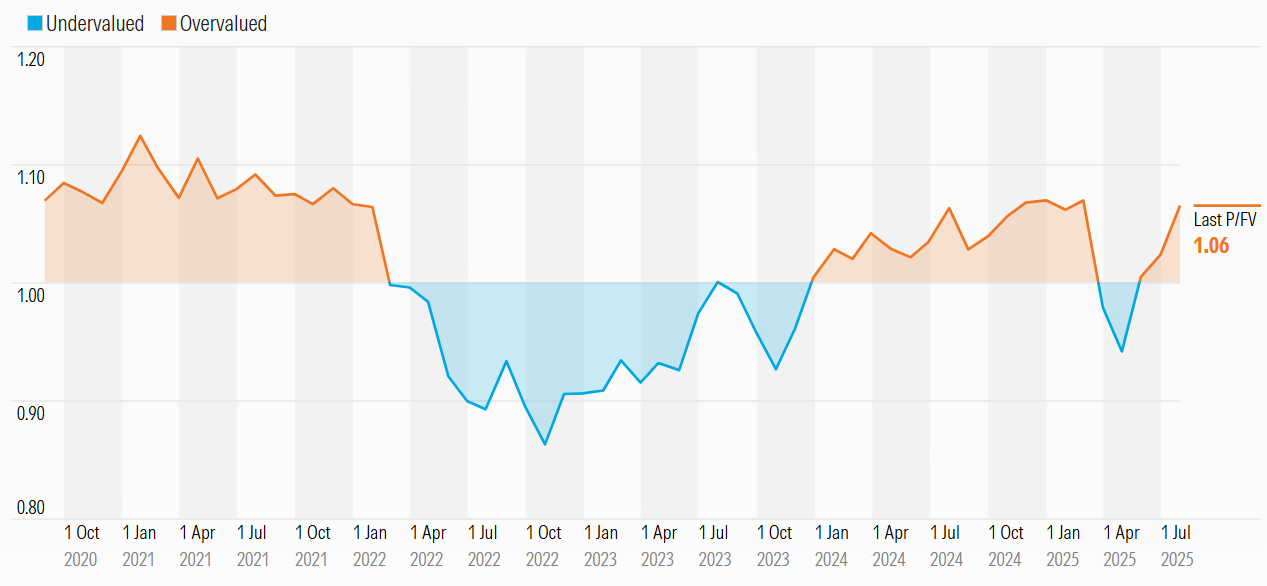
Source: Morningstar More consensus upgrades than downgrades for ASX large caps over week leading into August reporting season 
Source: Equitable Investors Share of US household assets owned by those aged 55 and above 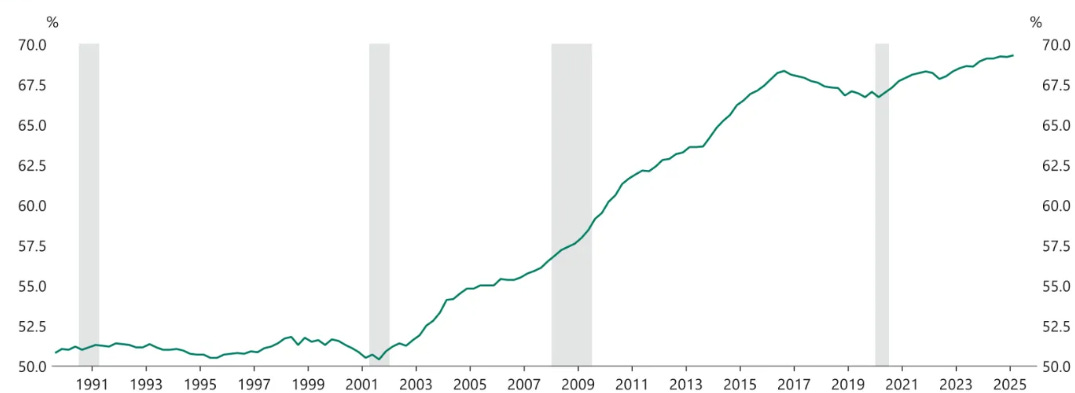
Source: Apollo Global Management Distribution of Australian household net worth by age group 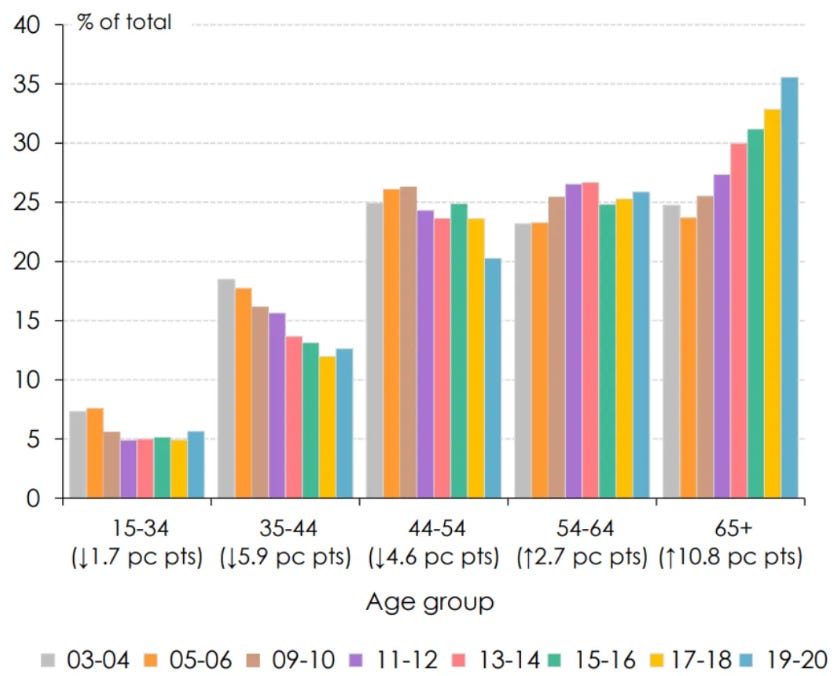
Source: Saul Eslake House price to income ratios 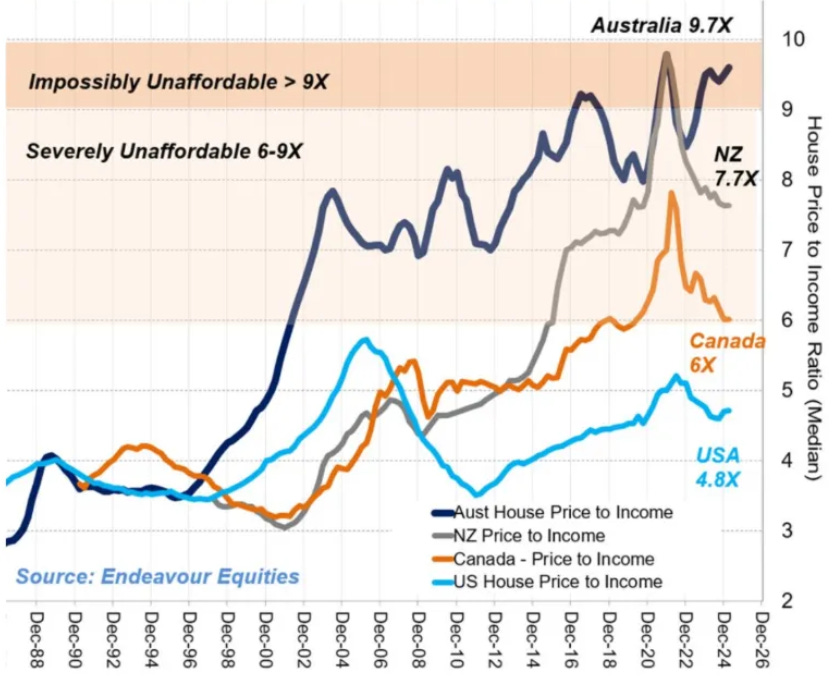
Source: Endeavour Equities Stablecoins the 18th largest external holder of US Treasuries 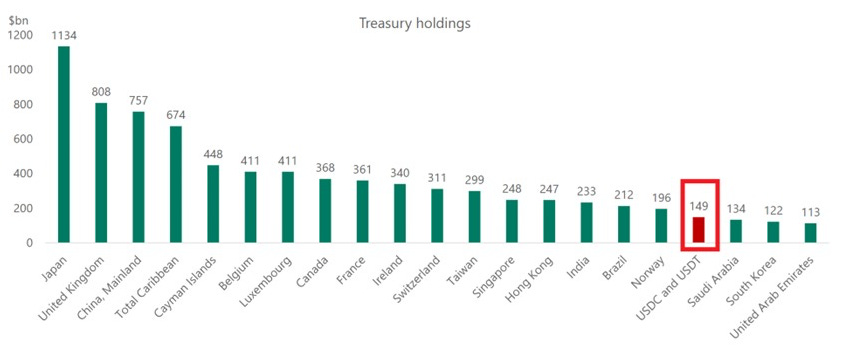
Source: The Kobeissi Letter China's working-age population expected to decline dramatically 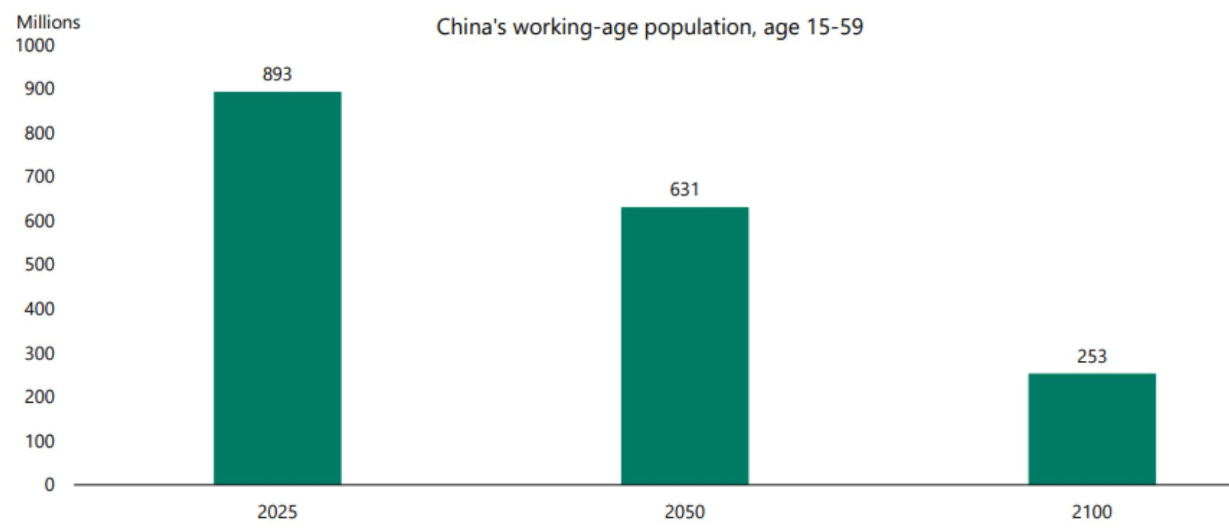
Source: Apollo via Forager Dr Copper has turned volatile - daily price changes 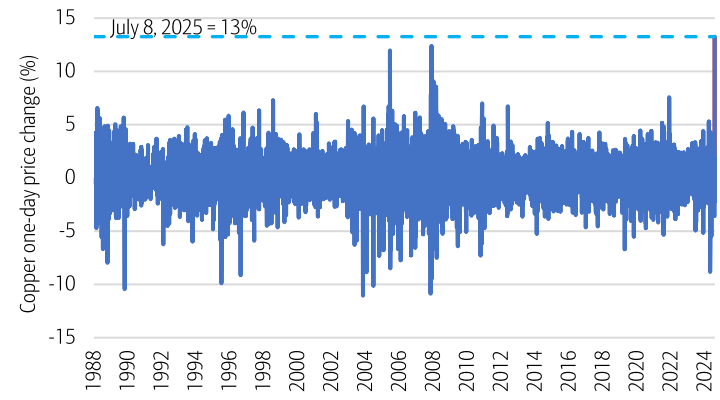
Source: BoAML August 2025 Edition Funds operated by this manager: Equitable Investors Dragonfly Fund Disclaimer Past performance is not a reliable indicator of future performance. Fund returns are quoted net of all fees, expenses and accrued performance fees. Delivery of this report to a recipient should not be relied on as a representation that there has been no change since the preparation date in the affairs or financial condition of the Fund or the Trustee; or that the information contained in this report remains accurate or complete at any time after the preparation date. Equitable Investors Pty Ltd (EI) does not guarantee or make any representation or warranty as to the accuracy or completeness of the information in this report. To the extent permitted by law, EI disclaims all liability that may otherwise arise due to any information in this report being inaccurate or information being omitted. This report does not take into account the particular investment objectives, financial situation and needs of potential investors. Before making a decision to invest in the Fund the recipient should obtain professional advice. This report does not purport to contain all the information that the recipient may require to evaluate a possible investment in the Fund. The recipient should conduct their own independent analysis of the Fund and refer to the current Information Memorandum, which is available from EI. |

